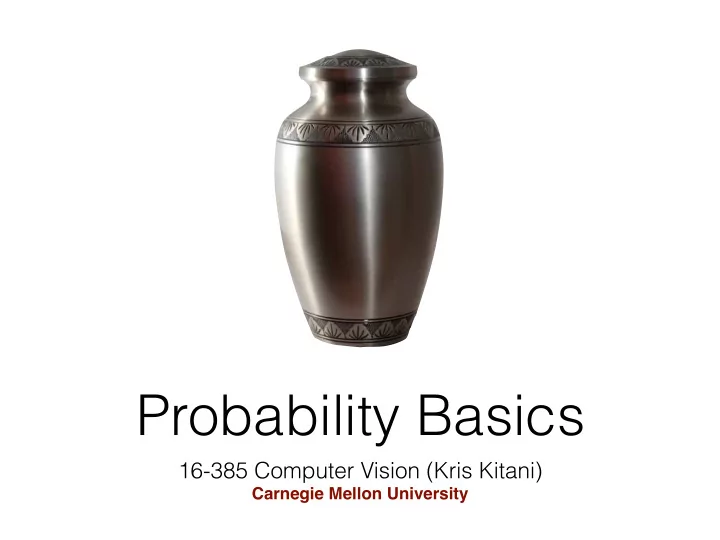

Probability Basics 16-385 Computer Vision (Kris Kitani) Carnegie Mellon University
Random Variable What is it? Is it ‘random’? Is it a ‘variable’?
Random Variable What is it? Is it ‘random’? Is it a ‘variable’? not in the traditional sense not in the traditional sense
Random Variable: a variable whose possible values are numerical outcomes of a random phenomenon http://www.stat.yale.edu/Courses/1997-98/101/ranvar.htm Random variable: a measurable function from a probability space into a measurable space known as the state space (Doob 1996) http://mathworld.wolfram.com/RandomVariable.html Random variable: a function that associates a unique numerical value with every outcome of an experiment http://www.stats.gla.ac.uk/steps/glossary/probability_distributions.html
random variable value outcome (index)
random variable outcome value (face of a penny) (heads or tails) 0: heads 1: tails What kind of random variable is this?
random variable outcome value (face of a penny) (heads or tails) 0: heads 1: tails Discrete. Can enumerate all possible outcomes
random variable outcome value (mass of a penny) (a number) 2.4987858674786832… grams
random variable outcome value (mass of a penny) (a number) 2.4987858674786832… grams What kind of random variable is this?
random variable outcome value (mass of a penny) (a number) 2.4987858674786832… grams Continuous. Cannot enumerate all possible outcomes
Random Variables are typically denoted with a capital letter X, Y, A, . . .
Probability: the chance that a particular event (or set of events) will occur expressed on a linear scale from 0 (impossibility) to 1 (certainty) http://mathworld.wolfram.com/Probability.html
0: heads 1: tails p ( X = 0) = 0 . 5 p ( X = 1) = 0 . 5 p ( X = 0) + p ( X = 1) = 1 . 0
2.4987858674786832… grams Z p ( x ) dx = 1
Probability Axioms: 0 ≤ p ( x ) ≤ 1 p (true) = 1 p (false) = 0 p ( X ∨ Y ) = p ( X ) + p ( Y ) − P ( X ∧ Y )
p ( X ∨ Y ) = p ( X ) + p ( Y ) − P ( X ∧ Y ) X ∧ Y X Y
Joint Probability p ( x, y ) When random variables are independent (a sequence of coin tosses) p ( x, y ) = p ( x ) p ( y ) When random variables are dependent p ( x, y ) = p ( x | y ) p ( y ) this is a conditional probability defined next …
Conditional Probability p ( x | y ) Conditional probability of x given y p ( x | y ) is the short hand for ? in terms of the random variables X and Y
Conditional Probability p ( x | y ) Conditional probability of x given y p ( x | y ) is the short hand for p ( X = x | Y = y ) How is it related to the joint probability? p ( x | y ) = p ( x, y ) ?
Conditional Probability p ( x | y ) Conditional probability of x given y p ( x | y ) is the short hand for p ( X = x | Y = y ) p ( x | y ) = p ( x, y ) p ( y ) Conditional probability is the probability of the union of the events x and y divided by the probability of event y
Bayes’ Rule likelihood p ( x | y ) = p ( y | x ) ? ? posterior What’s the relationship between the posterior and the likelihood?
Bayes’ Rule likelihood prior p ( x | y ) = p ( y | x ) p ( x ) p ( y ) posterior evidence (observation prior) How do you compute the evidence (observation prior)?
Bayes’ Rule likelihood prior p ( x | y ) = p ( y | x ) p ( x ) p ( y ) posterior evidence (observation prior) How do you compute the evidence (observation prior)? p ( y | x ) p ( x ) p ( x | y ) = P x 0 p ( y | x 0 ) p ( x 0 ) evidence (expanded)
Bayes’ Rule likelihood prior p ( x | y ) = p ( y | x ) p ( x ) p ( y ) posterior evidence Evidence (observation prior) is also called the normalization factor p ( x | y ) = η p ( y | x ) p ( x ) p ( x | y ) = 1 Z p ( y | x ) p ( x )
Bayes’ Rule with ‘evidence’ p ( x | y, e ) = p ( y | x, e ) p ( x | e ) p ( y | e )
Marginalization X p ( x ) = p ( x, y ) y Marginalize out y
Conditioning X p ( x ) = p ( x | y ) p ( y ) y Conditioned on y
Joint probability over three (dependent) variables p ( cavity ) =? X p ( x ) = p ( x, y ) Recall: y
Joint probability over three (dependent) variables p ( cavity ) =? p ( cavity ) = 0 . 108 + 0 . 012 + 0 . 072 + 0 . 008 = 0 . 2
Joint probability over three (dependent) variables p ( cavity | toothache ) =?
Joint probability over three (dependent) variables p ( cavity | toothache ) = p ( cavity, toothache ) p ( toothache ) 0 . 108 + 0 . 012 = 0 . 108 + 0 . 012 + 0 . 016 + 0 . 064 = 0 . 6
Recommend
More recommend